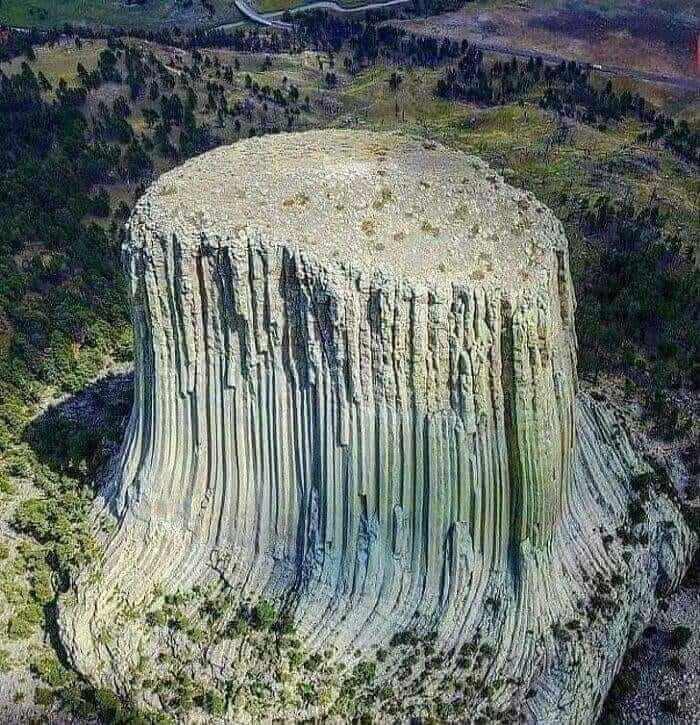
What The Devil? The Secret Behind Devils Tower
Devils Tower, an impressive formation amid a relatively flat region, raises natural questions among many viewers as to how it formed.
Tucked into a remote corner of northeastern Wyoming, Devils Tower juts dramatically up through the prairie, rising a staggering 867 feet from its base. Almost three times the height of the Statue of Liberty, Devils Tower is breath-taking for even the most seasoned travellers. Many of its visitors have marvelled over this gargantuan rock specimen; it’s impossible to look at the surrounding landscape and not wonder how on earth the tower got there. It seems spectacularly out of place, resembling nothing close to the gentle rolling hills and prairies nearby.
Established as the nation’s first national monument in 1906, Devils Tower’s origins have long intrigued geologists, Native Americans, and casual visitors alike. To this day, despite so much study and interest, experts are still baffled about much of its existence.
Sedimentary rock is created when minerals or organic material solidify. If you’re fossil hunting, you’re most likely picking through sedimentary rock. Wind and water help it form, making up much of the landscape around the tower. Because of that, geologists believe a shallow sea covered the area between 225 to 195 million years ago, during the Triassic Period. The water went through cycles of receding and returning for the next 59 million years, but something drastic was afoot.
Roughly 50 to 60 million years ago, the earth was in the Tertiary Period. It was a very busy time for the earth’s tectonic plates. It was during this time that the continents made their way close to where they are today. Sometimes the shifts were explosive, as plates crashed into one another, pushing up mountain ranges. Scientists believe it was then that our beloved Rocky Mountains and Black Hills were born. All of that movement meant volcanic activity was high, and molten rock below the crust surged toward the earth’s surface.
Nearly everyone agrees that Devils Tower was made from molten rock or magma, but that’s where the certainties end and the fun begins.
One theory from the late 1800s says that magma forced its way up through other rock layers, but the giant blob of hot rock stopped before reaching the surface, creating what’s known as a stock. It cooled underground, and erosion eventually washed away the softer rock surrounding the tower, exposing it over time.
A similar explanation is that the magma came up through the surface and ballooned through a weak layer, forcing the surface to bubble up without breaking through. The mushroom-shaped hunk of rock is called a laccolith, and other formations can be seen through the American southwest. In this case, geologists believe erosion would have worn away the edges of the mushroom.
Others believe Devils Tower was the centre of a volcano, one or two miles below the surface, with a kind of pipe reaching to the surface, and the tower acting as a plug. However, there is little evidence of other volcanic formations in the area. Still, the evidence could have been a victim of wind and erosion.
Finally, and perhaps the most fun theory to think about, is that the tower was part of a unique kind of volcano known as maar-diatreme. When magma billows up through a crack in the earth’s surface and encounters shallow pools of groundwater, the water heats up really, really fast. This superheated steam, mixed with volcanic gases, would trigger a series of explosions. The impressive sight could create a crater in the earth’s surface, which would fill with lava, and as it cooled, created a dome shape. The theory is that erosion did its work over the years, shaping and revealing the tower to what we have today.
Another thing to notice at Devils Tower is the peculiar columns on its sides. These columns can be found on other structures worldwide, but where Devils Tower has them beat is their size. Hundreds of feet high and up to ten feet wide, Devils Tower columns are in a class by themselves. It’s when you get up close to the tower and scan it for climbers that the columns get really impressive, as you can see just how massive they are.
Known as columnar jointing, these formations can only take place on igneous or volcanic rock. As the magma cooled and solidified – starting with the outer surface – it contracted, forming stress points, which led to cracking. Interestingly, these cracks grew outward in three directions, forming columns with six sides, or in a few instances, five. The hexagon is one of nature’s tightest and strongest fits. While boulders occasionally fall from the tower, no column has broken completely off in recorded history.
If you choose to investigate yourself – and you definitely should – it’s a four- to five-hour drive from Billings, and the Black Hills and Rapid City are on the other side of the drive.
The national monument is gradually opening to the public.
Check the website before your visit: (https://www.nps.gov/deto/index.htm)
* * *
King Solomon’s Tomb Reveals Hidden Secrets After 3,000 Years – The Shocking Truth!
For over 3,000 years, the Tomb of King Solomon has remained one of the most elusive and mysterious burial sites in history. A king renowned for his unparalleled wisdom and vast wealth, Solomon’s legacy has captivated scholars, archaeologists, and treasure hunters alike. Yet, despite countless searches, no one has definitively located the tomb—until now.
Recent discoveries in a remote region of ancient Jerusalem have unearthed evidence that could finally reveal the tomb’s location. But the most shocking revelation lies not in the discovery of the tomb itself—it’s what was found inside.

Within the excavation site, researchers uncovered artefacts and inscriptions that challenge everything we thought we knew about Solomon’s reign. Among the treasures were intricately carved gold and silver items, along with a series of stone tablets bearing cryptic messages. These artefacts suggest the tomb was far more than a burial site—it may have been a repository of secrets deliberately hidden to protect a sacred legacy.
One of the most puzzling discoveries is a set of stone tablets inscribed with an unknown ancient script. This writing, seemingly related to ancient Hebrew but featuring mysterious symbols, has left experts scrambling to decipher its meaning. Could these inscriptions unlock lost knowledge about early civilizations? Or might they reveal untold truths about Solomon’s spiritual beliefs and his connections to the divine?

The location of the tomb itself raises profound questions. Was it deliberately hidden by the ancient Israelites to shield it from invaders? Or was its concealment part of a grander design, meant to preserve Solomon’s memory and power in secrecy? Historical records celebrate Solomon’s achievements, particularly the construction of the First Temple in Jerusalem. Yet, these new findings suggest his legacy may hold even deeper, mystical dimensions.
Adding to the intrigue is the possibility of connections to other legendary figures and ancient civilizations. Some researchers speculate that Solomon’s wisdom transcended his era, influenced by knowledge inherited from earlier cultures—or perhaps even extraterrestrial sources. Could this tomb be the missing link to understanding ancient technologies and mysteries that have baffled historians for centuries?
The revelations surrounding King Solomon’s tomb leave us with more questions than answers. As researchers work tirelessly to piece together the clues, one thing is clear: this discovery opens a gateway to untold secrets of the ancient world.


What is the truth about Devils Tower?